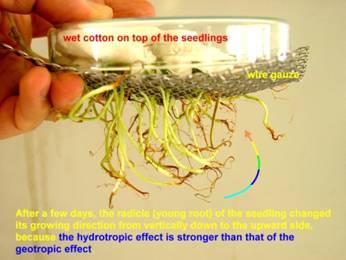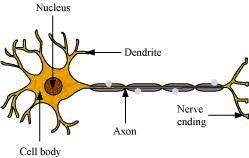Class 10 NCERT Solutions Biology Chapter 6 - Control and Coordination
Control and Coordination Exercise 105
Solution 1
A reflex action is an automatic spontaneous response to a stimulus. It does not involve any thinking. For example, when the bright light is focused on our eyes, we immediately close it.
Walking, on the other hand, is a voluntary action. It is acquired through learning. A voluntary action is under our conscious control.
Concept insight: Difference between voluntary and involuntary action should be clear.
Solution 2
Synapse is a small gap that occurs between the last portion of axon of one neuron and the dendrite of the other neuron. It acts as the passage for the transfer of the impulse in one direction only. The transfer of impulses occurs as the chemicals are produced in only one side of the neuron i.e., the axon's side. From axon, the impulses travel across the synapse to the dendrite of the other neuron.
Concept insight: Student should clearly remember the structure and function of neuron cell.
Solution 3
Cerebellum, a part of hindbrain is responsible for maintaining posture and equilibrium of the body.
Concept insight: Students should remember the main parts of brain and their function.
Solution 4
Our brain is divided into three main parts- forebrain, midbrain and hindbrain. Forebrain is the thinking part of our brain. It has separate areas that are specialized for hearing, smelling, sight, taste, touch, etc. The forebrain also has regions that collect information or impulses from the various receptors. When the smell of an incense stick reaches us, the olfactory receptors located in our forebrain detects it. Then, the forebrain interprets it by putting it together with the information received from other receptors and also with the information already stored in the brain.
Concept insight: Students should remember the main parts of brain and their functions.
Solution 5
Reflex action is a sudden response to a stimulus and do not involve any thinking. In a reflex action, the stimulus is detected by the sensory nerves that carry the impulse to the spinal cord where it is interpreted and the response is send back by the motor neuron. The pathway followed by the reflex action is called reflex arc. Reflex arc is formed in the spinal cord. The brain is only aware of the signal and the response that has taken place. However, the brain has no role to play in the creation of the response.
Concept insight: Students should be aware of the structure and function of reflex action.
Control and Coordination Exercise 108
Solution 1
Plant hormones or phytohormones are naturally-occurring organic substances synthesized in minute quantities in the plant body and help in regulating plant growth and other physiological processes. The five major types of phytohormones are auxins, gibberellins, cytokinins, abscisic acid, and ethylene.
Concept insight: Important from Exam point of view
Solution 2
The movement of leaves of the sensitive plant, Mimosa pudica or "touch me not"; occurs in response to touch or contact. Here, touch or contact acts as stimuli. This movement is independent of growth. The movement of shoot towards light is known as phototropism. This type of movement is directional and is growth dependent.
Concept insight: Students should be aware of growth movements and turgor movements.
Solution 3
Auxin is an example of growth-promoting plant hormone.
Concept insight: Students should remember various plant hormones and their functions.
Solution 4
Auxin is synthesized at the tip of shoot. It helps the cell to grow longer. When a tendril comes in contact with a support, auxin stimulates faster growth of the cells on the opposite side, so that the tendril forms a coil around the support. This is how auxins promote the growth of a tendril around a support.
Concept insight: Important from Exam point of view
Solution 5
Aim of the experiment: To demonstrate hydrotropism.
Method: Place germinating seeds in a moist saw dust or cotton contained in a sieve or mesh wire.
Observation: At first radicles appear and they grow downwards towards the gravity. After sometime the radicles again bend back and move towards the sieve containing saw dust or cotton.

Conclusion: Roots show both hydrotropic as well as geotropic response. Hydrotropic response is stronger than geotropic response.
Concept insight: Suggested exam type question.
Control and Coordination Exercise 111
Solution 1
Chemical coordination in animals take place with the help of hormones. Hormones are the chemical messengers that regulate the physiological processes in living organisms. Hormones are secreted by endocrine glands. Hence, we can say that the chemical coordination in animals take place through the endocrine system.
Concept insight: Important from Exam Point of View.
Solution 2
Iodised salt is advised for the normal functioning of the thyroid gland. Iodine stimulates the thyroid gland to produce thyroxin hormone. It also regulates carbohydrate, fat, and protein metabolism in our body. Deficiency of this hormone results in the enlargement of the thyroid gland. This is called goiter, which is characterized by a swollen neck.
Concept insight: Students should remember the location and function of thyroid gland.
Solution 3
Adrenaline is a hormone secreted by the adrenal glands. It is also known as emergency hormone. It is produced in response to joy, anger, fear or any kinds of stress.
When secreted in large amounts, it speeds up the heartbeat and increases the blood supply to skeletal muscles, increases the breathing rate and blood pressure. All these responses enable the body to deal with any stress or emergency.
Concept insight: Students should remember the location and function of adrenal gland.
Solution 4
Diabetes is a disease in which the level of sugar in the blood rises. Insulin is the hormone secreted by the pancreas that helps in regulating the blood sugar level. So, diabetic patients are treated by giving injections of insulin.
Concept insight: Students should remember the location and function of pancreas.
Control and Coordination Exercise 112
Solution 1
(d) Cytokinin is a plant hormone.
Concept insight: Student should clearly remember all the plant and animal hormones and their function.
Solution 2
(b) The gap between two neurons is called a synapse.
Concept insight: Student should clearly remember the structure and function of neuron cell.
Solution 3
(d) The brain is responsible for thinking, regulating the heart beat and balancing the body.
Concept insight: Student should remember the structure and function of brain.
Solution 4
Receptors are sensory structures (organs/tissues or cells) present all over the body. The receptors are either grouped, such as, in case of eye or ear, or scattered, like, in case of skin. All the information from the environment is detected by the receptors.
Functions of receptors:
(i) They sense the external stimuli.
(ii) They pass on the information in the form of electrical impulse to brain by nerve cells.
(iii) The brain then sends the response in the form of electrical impulse to the effector organ for the response.
If the receptors do not work properly then the information from the environment will not be detected and the body will not respond accordingly.
Concept insight: Important from Exam point of view
Solution 5
Neuron or nerve cells are the functional units of the nervous system. The three main parts of a neuron are axon, dendrite, and cell body.
 Structure of a neuron
Structure of a neuron
Functions of the three parts of a neuron:
Axon: It conducts messages away from the cell body.
Dendrite: It receives information from axon of another neuron and conducts the messages towards the cell body.
Cell body: It contains nucleus and cytoplasm. It is mainly concerned with the maintenance and growth.
Concept insight: Student should clearly remember the structure and function of neuron.
Solution 6
The growth movement in plants in response to light stimulus is known as phototropism. The shoots show positive phototropism and the roots show negative phototropism. This means that the shoots bend towards the source of light whereas the roots bend away from the light source.
Concept insight: Student should know the various types of tropic movements in plants.
Solution 7
The reflex arc connections between the input and output nerves meet in a bundle in the spinal cord. In fact, nerves from all over the body meet in a bundle in the spinal cord on their way to the brain. In case of any injury to the spinal cord, the signals coming from the nerves as well as the signals coming to the receptors will be disrupted.
Concept insight: Students should remember the structure and the functions of spinal cord
Solution 8
Chemical coordination in plants occurs with the help of hormones. Plant hormones or phytohormones are naturally-occurring organic substances synthesized in minute quantities in the plant body and help in regulating plant growth and other physiological processes. The five major types of phytohormones are auxins, gibberellins, cytokinins, abscisic acid, and ethylene.
Concept insight: Suggested exam type questions.
Solution 9
A multicellular organism has diverse structure and functions. The maintenance of the body functions in response to changes in the body by working together of various integrated body systems is known as coordination. All the movements that occur in response to stimuli are carefully coordinated and controlled. In animals, the control and coordination movements are provided by nervous and endocrine system.These two systems controls and coordinates by:
(i) The release of chemical messengers called the hormones from the endocrine system.
(ii) By the conduction of nerve impulse from the nervous system.
Concept insight: Suggested exam type questions.
Solution 10
| Involuntary actions | Reflex actions |
| i. Involuntary actions cannot be consciously controlled. | i. Reflex actions are sudden, unconscious automatic response to some change in an environment. |
| ii. These actions are however directly under the control of the brain. | ii. These are controlled by spinal cord. |
Concept insight:
(i) Differences should always be written in tabular form.
(ii) Differences should be written in terms of their significance.
(iii) Write only those many numbers of differences as stated in the question.
(iv) Give example wherever possible.
Solution 11
| Nervous system mechanism | Hormonal system mechanism |
| i. The information is conveyed in the form of nerve impulse. | i. The information is conveyed in the form of chemical messengers. |
| ii. The nerve impulses are conducted through nerve fibres. | ii. The information is transmitted or transported through blood. |
| iii. The flow of information is rapid and the response is quick. | iii. The information travels slowly and the response is slow. |
| iv. Its effects are short lived. | iv. It has prolonged effects. |
Concept insight:
(i) Differences should always be written in tabular form.
(ii) Differences should be written in terms of their significance.
(iii) Write only those many numbers of differences as stated in the question.
(iv) Give example wherever possible.
Solution 12
| Movement in sensitive plants | Movement in our legs |
| i. Movement that takes place in a sensitive plant such as Mimosa pudica occurs in response to touch (stimulus)is an example of involuntary action. | i. Movement in our legs is an example of voluntary action. |
| ii. For this movement, the information is transmitted from cell to cell by electro-chemical signals as plants do not have any specialised tissue for conduction of impulses. | ii. The signal or messages for these actions are passed to the brain and hence are consciously controlled. |
| iii. For this movement to occur, the plant cells change shape by changing the amount of water in them. | iii. In animal muscle cells, some proteins are found which allow the movement to occur. |
Concept insight:
(i) Differences should always be written in tabular form.
(ii) Differences should be written in terms of their significance.
(iii) Write only those many numbers of differences as stated in the question.
(iv) Give example wherever possible.
